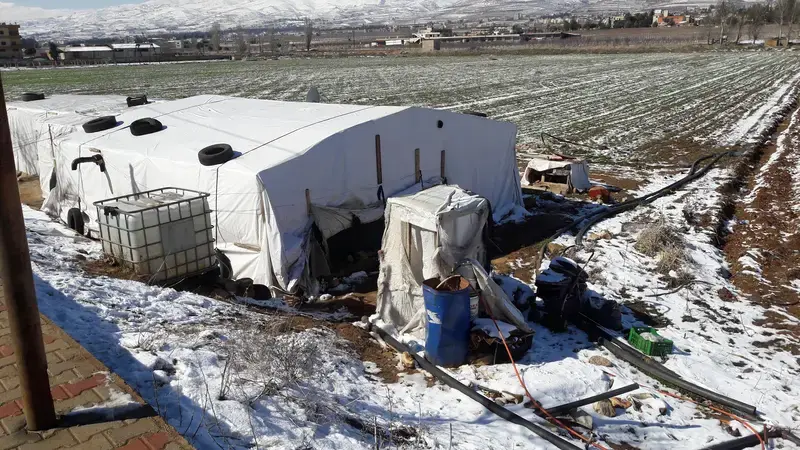Enhancing the livelihood and food security of Syrian refugees in Lebanon

Syrian refugees in the Bekaa Valley, Lebanon, have found security from the ravaging conflict in Syria. However, in spite of the commendable efforts from the host country and the UN, as well as other international and local humanitarian organizations, the support provided has failed to meet the humanitarian standards set by those organizations.
A diagnosis of the livelihood situation of the Syrian refugees in Beqaa valley, Enhancing the Livelihood and Food Security of Syrian Refugees (January 2019. 53 pages) was presented during a meeting on Employment barriers of Syrian refugees in Lebanon (Oxford 15/01/2019) by Dr Saja Al Zoubi (an Agricultural Economist and visiting researcher at Oxford, Department of International Development). She also organised a on 15th of June a Workshop on: Livelihoods and Socio-Economic Inclusion of Syrian Refugees in Host Countries. This workshop examined the socio-economic impacts of displacement on Syrian refugees from a variety of perspectives, including using a gender lens.
Overall, agricultural work is concentrated in the shorter period up to 3 months, while all non-farm work, when combined, has a longer occupational period with 42 percent having work for over 5 months. The non-farm work, such as nonseasonal work as a teacher, worker at (restaurants, shop, dressmaker) and maintenance are rare to find but provide longer periods of work. Work in food-processing factories (pickles and tomato paste) is also highly seasonal as it is connected to agriculture. Agricultural work is seasonal mainly in summer, so not much work is available in winter except in greenhouses.
Homestead micro-food production
Syrian refugees in Lebanon are facing significant food insecurity and poverty. Their main income from agricultural labor is insufficient to alleviate their poverty. Non-agricultural jobs are very difficult and not attainable and are considered to be in competition with Lebanese workers. Syrian refugees are mainly involved in agricultural value chains as wage labor, but that is not sufficient to improve their food security or pull them out of poverty. The only remaining option is to find ways that enables them to access agricultural assets: land and livestock. The report proposes four interventions for Syrian refugees in the Beqaa Valley: (a) Access to rental land; (b) Training in good agricultural practices (GAP); (c) Small ruminant enterprises; (d) Dairy processing.
Debt is the most important source of financing access to food. All refugee families reported that they purchase their food mainly by credit, but at different levels. Although 76 percent of refugee families get food vouchers as aid provided by humanitarian agencies, food vouchers do not cover all household needs and they do not have enough income to supplement food aid. Picking up crop leftovers in fields after harvest and wild herbs are the second most important source of food as reported by 85 percent of the households, and charity from host communities (NGOs, local people) is the lowest.
One way that households cope with food insecurity is through home-based food production. In this study, only 26 percent of interviewed families had homebased livestock production with a few animals in the order of 3 chickens, 5 lambs/sheep and 2 goats, on average. These micro-enterprises generate consumed food at the value of about LBP90,000 per season from chicken, LBP205,000 from sheep, and LBP22,6875 from goats. These are mainly used for household consumption.
Home gardens were not found among the interviewed households in this study and their explanation was lack of sufficient space and water. There were some cases of pot plantings. Halimah, a refugee lady, planted onion and mint in pots and said, “I wish I can plant more but there is no space.” Um Hussain said: “I planted onion, but it was damaged by children; our homes are not protected and there is no enough space to have a garden.” Refugees also try to add value to the crops they pick up through different home food processing (55 percent). These include making pickles—an important secondary component in dinner—and preparing jam, pepper or tomato paste, and also, they make cheese and yogurt, and make their own bread.
200 vegetable gardens
The different activities conducted in the framework of the project 200 vegetable gardens is therefore a welcoming initiative so support good agricultural practices. The seed bank and training center - Saadnayel farm - represents an important source of subsistence and education for Syrian and Lebanese families living in the area. It also preserves the agricultural heritage using traditional approaches. It targets marginalized families in the Khiam and Bekaa regions and is equally benefitting Syrian and Lebanese families. The project was visited by the United Nations Coordinator in Lebanon and the World Food Programme (WFP) in June 2019.
REFERENCES:
